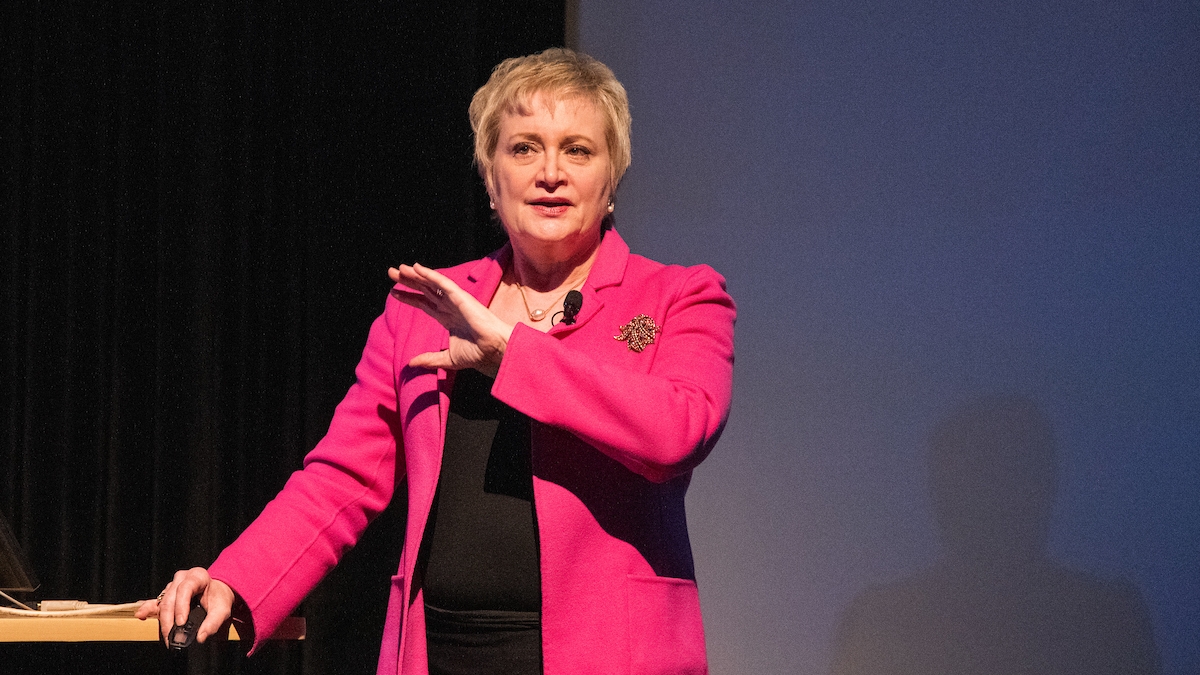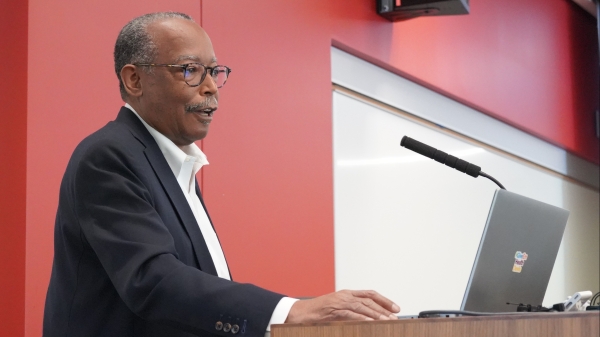Health care needs to move to the community for better access, expert says
Researcher describes how technology can drive innovation at McKenna Lecture

The hospital of the future will likely be in your living room, enabled by technology and traveling clinicians, according to an expert in health care innovation.
“We know health care is moving outside of the conventional walls increasingly to more distributed settings, and whether that’s an MRI at the mall or outpatient surgery, we know it’s moving closer to where people are in their homes and work sites,” said Susan Dentzer, president and CEO of the Network for Excellence in Health Innovation.
Dentzer, who researches the use of technology in health care, gave a talk titled “Health Care Without Walls” at Arizona State University on Thursday as the 10th annual McKenna Lecture, presented by the Health Sector Supply Chain Research Consortium in the W. P. Carey School of Business at ASU.
“It’s useful to ask basic questions about innovation in health care,” she said.
“One is, ‘What if, instead of a sick care system, we had a health care and health-inducing system that went to the people?’”
The United States has the most expensive health care system in the world, even as life expectancy for Americans has been declining, she said.
And while much of medicine involves direct contact with health care workers, not all of it is.
“A lot of health care is about the exchange of information. ‘What are your symptoms?’ 'How long have you had them?’ Why not do more of that virtually?” she said. “Health care is behind almost every other major sector in our economy in terms of information technology.”
Dentzer said that technology-enabled health care can increase convenience and access while reducing costs. She gave several examples.
• A neurologist in upstate New York sees his Parkinson’s patients via Skype. Dentzer said studies show that a 40-minute doctor visit requires about four hours of time for a Parkinson’s patient and a caregiver. “More than half the patients actually preferred the Skype to the in-person visits because it was a lot easier and the visits were actually longer,” she said.
• “Hospital at Home” is a program at Johns Hopkins that focuses on patients who would typically be hospitalized, such as an elderly person with pneumonia. The program takes the equipment and home health aides to the patients’ homes. “This produces a 20% decrease in mortality compared to a control group of people who were hospitalized, and the cost per stay was 19% lower,” she said.
• The Veterans Administration has recently increased the use of telehealth, with more than 900,000 veterans using virtual care, such as video or phone visits. Two-thirds of them were treated for mental health issues, she said.
Dentzer said that in the Kaiser Permanente health care system, which includes about 20% of all Americans, nearly 60% of all visits last year were virtual, through video or phone calls or email.
Technology-enabled health care can also focus more on prevention, she said.
“Think of a response to a pandemic flu scenario, which seems pretty topical today,” she said.
“What about the ‘worried well’? Could we text people to wash their hands? That’s the most important intervention we have at the moment because we don’t have a vaccine or effective drugs (for the COVID-19 virus),” she said.
“The last thing we want is people showing up at a health care setting if they’re not really sick.”
Other industry disruptions, such as music-streaming services, have primed consumers to demand more convenience and efficiency through technology, she said. She said that there are already amazing technological advances in health care.
• A smartphone app allows clinicians to upload de-identified images of a patient to crowd-source a diagnosis from other doctors.
• A new machine-learning software system can diagnose diabetic retinopathy, which is historically underdiagnosed. The system viewed millions of images of retinas to “learn” the symptoms, which typically were only found at an office visit with an ophthalmologist. “Now it can be used by a home health aide, who can take a scan and send it off,” she said.
• Amazon sells an otoscope that attaches to a smartphone, so parents can take a photo of their child’s eardrum and send it to their pediatrician, potentially eliminating unnecessary visits for ear infections. “I would have killed for this device when my children were little,” she said.
There are significant obstacles to adopting these innovations across the entire health care industry, she said.
“The No. 1 hurdle we have to get over is inertia: ‘That’s not how we do things here,’ ‘You have to come in for that appointment,’” she said.
Payment models would have to change. In the Kaiser Permanente system, clinicians are salaried and many of the patients also have their health insurance through the institution.
“The role for clinicians is not, ‘How many patients can you see in a day?’ It’s, ‘How many patients’ problems can you solve in a day?’” she said. “In the right payment structure, there’s an opportunity for, if not savings, than a much more efficient use of resources.”
There are also a patchwork of state and federal laws and regulations on data privacy and security.
“We don’t even have a plan to get universal broadband. Botswana has a plan to get universal broadband, but we do not,” she said.
A technology-enabled system could dramatically increase access to care and reduce lost productivity and absenteeism while cutting costs, she said, even though it could still be susceptible to disparities due to income inequality.
“Is there a potential to do the right thing and get the right care to the right patients at the right time? Yes,” she said.
“We know we can do it. It’s, ‘Do we have the will?’”
Top image: Susan Dentzer, president and CEO of the Network for Excellence in Health Innovation, gave a talk titled “Health Care Without Walls” at Arizona State University on Thursday. Photo by Meg Potter/ASU Now
More Health and medicine

College of Health Solutions hosts visit from leading expert in genomic research
Some fortunate Arizona State University faculty, staff and students were able to gain valuable insights and perspective during a visit by one of the country’s leading figures in health and scientific…

Indigenous ASU research team recommends assistance for tribal members still reeling from COVID-19’s effects
When Matt Ignacio’s tribe, the Tohono O’odham Nation, donated $1 million to Arizona State University to support COVID-19 research, he applied for some of the money to understand and report any…

Tips for staying hydrated during Pat's Run and other outdoor activities
By Aidan Hansen Staying hydrated and listening to your body during outdoor exercise activities is crucial to one's health and safety, especially in warm climates. And with the average daytime high…